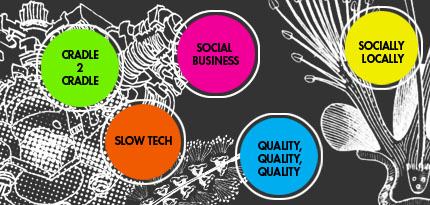The heydays of industrial capitalism are nearing their end. Gitte Larsen presents five models for the sustainable growth of the future in the new Danish magazine “Culturel”. Get an overview of the five models:
Cradle2Cradle
Views all waste as food for future processes, the production, use and disposal of products as a closed circuit where all materials must be reintegrated in the process continually. This places considerable demands on designing the system, because the entire process must be interlinked in a holistic framework, a metabolism where all materials are viewed as circulating nutrients.
The men behind C2C view the concept as the seed of a new industrial revolution, the eco-paradigm of the 21st century, encompassing co-working with the earth, optimal use of natural resources and creating genuine progress for mankind – enriching work lives and nurturing awareness of coherency and reciprocity. Even Ford, the father of industrialization, has reorganized their assembly lines in accord with C2C principles. They report falling energy cost and increased employee satisfaction.
Social business
As described by Danish Tanya Ellis in The New Pioneers – Sustainable Business success through social innovation and entrepreneurship. She outlines a new sustainable business model – or maybe even a growth model. While Corporate Social responsibility has already been widely accepted and legislated, Corporate Social Innovation is still appearing in many firms’ agendas. Social Innovation is defined by fulfilling social needs with new solutions, and with CSI firms can incorporate the social aspect into their core business – making it a primary ingredient of market or product strategies instead of just icing on the cake. Why not make money by being sustainable?
Slow tech
We normally think of technology as something to speed up processes, effective means to an end. The technological enthusiasm of the futurist movement 100 years ago was all about speed and mankind’s mastery over nature – slow tech is the complete opposite: slowing down, connecting with surroundings and strengthening the bonds. The nascent Slow Tech movement is a more organic approach to development, as it draws on more faculties than just the rational mind. When technology takes nature, body, sensations and aesthetics into account, the process takes primacy to the result. Slow Tech might be our possibility to engage the creative potential of people and society – a hope for a sustainable future.
Quality, Quality, Quality
The discerning consumer knows that every time quality is compromised, replacement is imminent. Discount may suffice, but quality is more satisfying now and sustainable in the long run. Add to that that products are often produced locally by skilled and well compensated craftsmen keeping the trade alive, rather than shipped across the world from demeaning factory floors and the choice seems obvious.
Socially Locally
The political consumer and her off spins will choose products that live up the ideals, whether it is personal health, working conditions, climate or environment. She will purchase locally, according to season and minimize waste. She always picks products that are organic, biodynamic, fair-trade, hypoallergenic or produced according to C2C. Will she pick yours?


